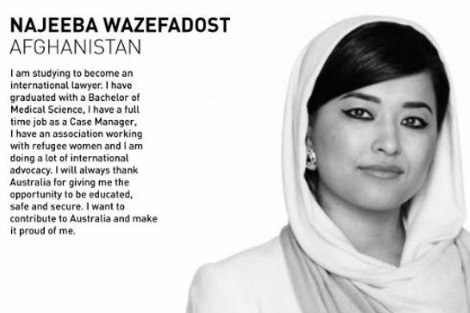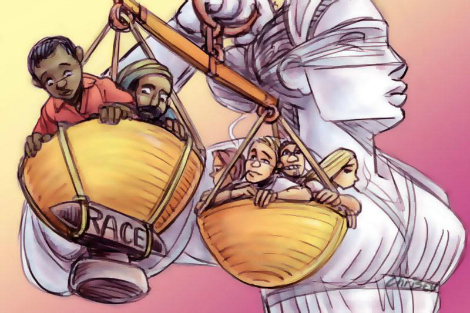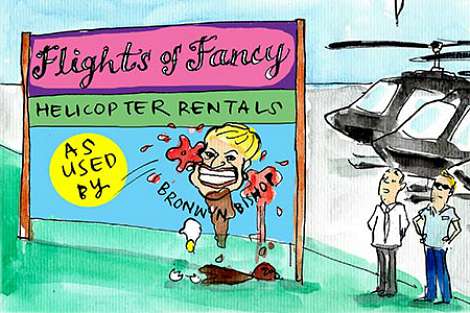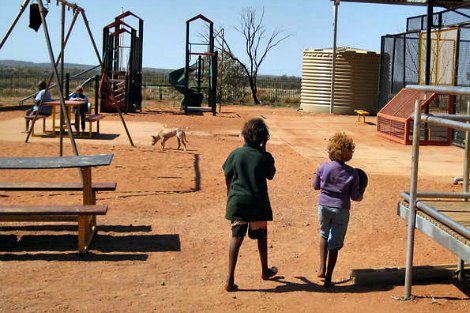Keywords: Sbs
There are more than 200 results, only the first 200 are displayed here.
-

AUSTRALIA
- Somayra Ismailjee
- 20 May 2016
33 Comments
The irony of trying to negate these stereotypes is that in doing so, we are still cheapening asylum seekers to political tools, stripping them of their humanity and multiplicity. Aiming to counter such rhetoric as Dutton's with stories of high-achieving refugees plays into a toxic game that legitimises the same negative stereotypes by engaging with them. Just as invisibility dehumanises asylum seekers, so does the hypervisibility we attribute to a select few stories.
READ MORE 
-

AUSTRALIA
- Celeste Liddle
- 01 February 2016
27 Comments
On the day of the Invasion Day rally in Melbourne, I was abused for wearing a pro-Aboriginal rights t-shirt. I wasn't shocked. Indeed, I even expected it. It is not the first time I have been abused as an Indigenous activist on Australia Day. What did shock me were the media reports on the rally. When I read that the densely packed, energetic, noisy crowd consisted of only 150 people, I was surprised, to say the least. I and other seasoned protesters estimated the crowd at around 3-5000.
READ MORE 
-

MEDIA
- Rochelle Siemienowicz
- 13 January 2016
The success of the Australian comedy The Dressmaker is thrilling to those watching the local film industry. There's more to cheer in the fact the film is proudly female in both story and production. We're not as bad as Hollywood, but even in Australia, there are not enough films for women, about women and by women. Since the 1970s male directors have been responsible for more than 85 per cent of the feature films made. Why does it matter? Because women are more likely to tell stories about women.
READ MORE 
-

AUSTRALIA
- Andrew Zammit
- 11 January 2016
2 Comments
In September Sydney's Daily Telegraph ran the headline 'Schoolyard Terror Blitz', reporting that 'schoolteachers will be given access to radicalisation information awareness kits explaining how to identify students at risk and what they should do to intervene as concerns grow about the rise of teen terrorists'. As the government prepares to address the involvement of schoolchildren in violent extremism, a controversial program in the UK shows a dangerous path that Australia must avoid.
READ MORE 
-

AUSTRALIA
- Ruby Hamad
- 30 November 2015
10 Comments
It is naive to equate racism with individual acts of bigotry. The current anti-Muslim and anti-Arab sentiment for instance goes deeper than sporadic attacks against individuals. Australian jobseekers with Middle-Eastern sounding surnames must submit up to 64 per cent more resumes than someone with an Anglo name in order to secure an interview. People may not actively engage in racist displays against Arabs, but that doesn't mean they are willing to spend time in close proximity to them.
READ MORE 
-

MEDIA
- Rochelle Siemienowicz
- 23 November 2015
10 Comments
The success of the Australian comedy The Dressmaker is thrilling to those watching the local film industry. There's more to cheer in the fact the film is proudly female in both story and production. We're not as bad as Hollywood, but even in Australia, there are not enough films for women, about women and by women. Since the 1970s male directors have been responsible for more than 85 per cent of the feature films made. Why does it matter? Because women are more likely to tell stories about women.
READ MORE 
-

AUSTRALIA
- Andrew Zammit
- 14 October 2015
8 Comments
In September Sydney's Daily Telegraph ran the headline 'Schoolyard Terror Blitz', reporting that 'schoolteachers will be given access to radicalisation information awareness kits explaining how to identify students at risk and what they should do to intervene as concerns grow about the rise of teen terrorists'. As the government prepares to address the involvement of schoolchildren in violent extremism, a controversial program in the UK shows a dangerous path that Australia must avoid.
READ MORE 
-

ARTS AND CULTURE
- Bernard Appassamy
- 16 September 2015
4 Comments
400 years ago, when Mauritius was still uninhabited, a cyclone thrust three tall ships of the Dutch East India Company against the coral reef. As the ships were ripped apart and thousands of Ming porcelain pieces on board smashed, the crew fought for their lives, but 75 men including the fleet commander Admiral Pieter Both, drowned. I picture that Sunday afternoon in the 1980s when my mother and I were wading in the water close to a familiar beach and found washed up shards of the porcelain.
READ MORE 
-

AUSTRALIA
- Fatima Measham
- 11 August 2015
12 Comments
Words like rorter, bludger and leaner only ever seem to apply to those who apply for welfare. A politician who draws down unreasonably on entitlements or a banker who earns stratospheric bonuses are seen as passive beneficiaries of the system. It seems the case that only those with power or capital are allowed to blame systems. The rest of us get to be individuals who make choices.
READ MORE 
-

AUSTRALIA
- Somayra Ismailjee
- 15 June 2015
16 Comments
There is a particular anatomy to the process of othering. In any context, the formula consists of propaganda, hatred, division, suppression and control. I'm from Perth. Some people would dispute this due to my brown skin and non-Anglo name. But I was born here, and have lived here for my entire life. Still, people like me are too often considered Australian only by law, and not by sociocultural connotation.
READ MORE 
-

MEDIA
Just because you can legally say something, doesn't mean you should — or that it is professionally responsible to do so. As SBS presenter Scott McIntyre discovered when he was sacked for his controversial tweets about Anzac Day, the internet can sometimes be a treacherous place to test the boundaries of 'acceptable' free speech. McIntyre learned this lesson the hard way, and he is hardly the first to do so.
READ MORE 
-

AUSTRALIA
- Michele Madigan
- 07 April 2015
30 Comments
WA accepted the Federal Government's one off $90 million grant to transfer funding for remote Aboriginal communities, many of which will be closed down. Meanwhile in South Australia, the State Government is challenging the Federal Government to uphold the responsibilities it has held since 1973. But it is cutting the communities' funding by 90 per cent.
READ MORE 